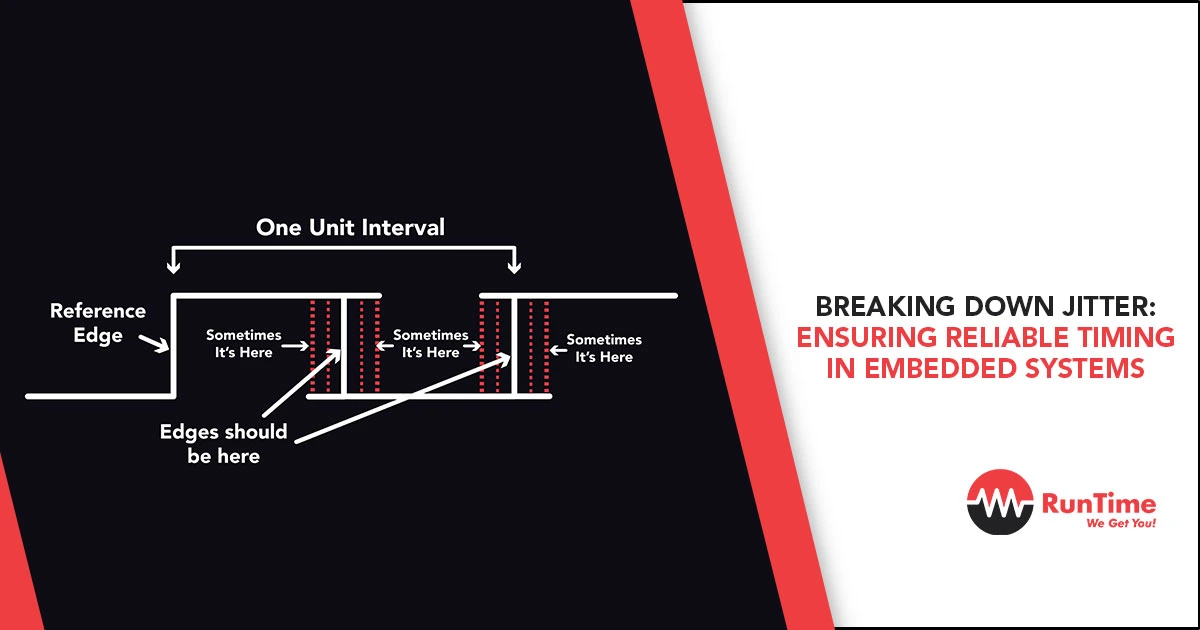Welcome to the intricate world of embedded systems, where precision and accuracy are paramount. In this exploration, we delve into the concept of ensuring reliable timing in embedded systems. The challenge of maintaining system reliability and performance is encapsulated in the complexities we unravel. Join us as we navigate through the nuances, exploring causes, effects, and methodologies crucial for achieving dependable timing. Through this journey, we unravel the secrets to enhancing the robustness and stability of embedded systems, ensuring seamless operation in various applications. Let’s embark on this insightful voyage to master the art of safeguarding the integrity of timing mechanisms.
Exploring Reliable Timing Requirements
Jitter, in the context of embedded applications, can have a significant impact on meeting timing requirements, especially in systems that rely on precise timing for real-time control, industrial automation, and communication protocols. Jitter refers to the variability in the timing of events, which can result in inaccuracies and disruptions in data processing and communication. To ensure precise timing in such environments, engineers employ various strategies:.
- Buffering Data: One approach to mitigate jitter is by buffering data, which involves storing data temporarily before processing it. This helps in smoothening out timing variations and ensuring a more consistent flow of information.
- Real-Time Operating Systems (RTOS): Implementing RTOS is another effective strategy to handle timing requirements in embedded systems. RTOS provides deterministic scheduling and priority-based task management, reducing the chances of timing irregularities.
- Hardware Timers and Interrupts: Using hardware timers and interrupts can help in achieving precise timing in embedded systems. Timers can be used to trigger events at specific intervals, while interrupts allow the system to respond to critical events promptly.
- Code Optimization: Optimizing code execution plays a vital role in minimizing interrupt latency and reducing the overall system response time. By writing efficient and optimized code, engineers can enhance the system’s ability to meet timing constraints.
By implementing these strategies to address jitter, embedded systems can meet stringent timing requirements and maintain reliability in critical applications.
In addition to the mentioned strategies, another important aspect to consider in ensuring reliable timing requirements is the synchronization of clocks. Clock synchronization is crucial in systems where multiple devices need to coordinate their actions based on a common time reference. By aligning the clocks across different components of the system, engineers can reduce timing discrepancies and ensure smooth operation.
Furthermore, redundancy mechanisms such as dual-redundant systems can enhance reliability in critical applications. Redundancy provides backup functionality in case of failures, minimizing the impact of timing disruptions and ensuring continuous operation.
Moreover, fault-tolerant design practices, like error detection and correction techniques, can be integrated into embedded systems to detect and rectify timing errors proactively. These mechanisms add an extra layer of reliability to the system, improving its overall performance and robustness.
Overall, by combining buffering techniques, RTOS implementation, hardware timers, code optimization, clock synchronization, redundancy mechanisms, and fault-tolerant design, engineers can create highly reliable embedded systems that meet stringent timing requirements and operate effectively in critical applications.
Understanding Latency, Jitter, and Their Differences
Distinguishing between Latency and Jitter
Latency and jitter are critical factors that significantly influence the performance and behavior of systems. It is imperative to grasp the distinctions between these two terms to enhance system efficiency.
Latency: The Delay Factor
Latency denotes the time taken for a data packet to traverse from its source to the destination. In essence, it represents the delay in transmitting data. High latency levels can lead to sluggish response times, adversely affecting the overall user experience and system performance.
Jitter: The Variability Element
Conversely, jitter embodies the fluctuation in latency. It illustrates the irregularity in the timing of data packet delays. Jitter can introduce packet loss, disorder in packet sequence, and general instability within the system, impacting its reliability and functionality.
Effects of Latency and Jitter on System Behavior
The influence of latency and jitter on system behavior and performance is profound. Several notable effects include:.
- Decreased Throughput : Elevated latency and jitter levels can curtail the overall throughput of a system, resulting in slower data transmission rates.
- Increased Packet Loss : Jitter may contribute to packet loss occurrences, necessitating retransmissions and causing additional delays in data delivery.
- Quality of Service (QoS) Challenges : Systems grappling with high latency and jitter may encounter difficulties in meeting quality of service benchmarks, thereby affecting user satisfaction levels.
- Network Congestion : Latency and jitter issues can exacerbate network congestion problems, leading to bottlenecks and a decline in overall system performance.
Mitigating Latency and Jitter Effects
To effectively optimize system performance and reliability, proactive measures must be implemented to manage latency and jitter. Such strategies may involve:.
- Quality of Service (QoS) Prioritization : Prioritizing critical data flows can help mitigate latency and jitter issues, ensuring smoother data delivery.
- Network Bandwidth Management : Implementing bandwidth management techniques can aid in alleviating congestion and reducing latency and jitter effects.
- Packet Loss Recovery Mechanisms : Employing packet loss recovery mechanisms, such as forward error correction, can mitigate the impact of jitter-induced packet loss.
- Real-time Monitoring and Analysis : Continuous monitoring and analysis of latency and jitter metrics can facilitate prompt identification and resolution of performance issues.
By comprehensively understanding and effectively managing latency and jitter, systems can be optimized to deliver enhanced performance, reliability, and user satisfaction.
Mitigation Strategies for Jitter in Embedded Systems
Jitter, the variation in timing of signals or data in embedded systems, can lead to performance issues and affect the reliability of the system. To address this challenge, implementing jitter mitigation strategies is essential. By following best practices, such as clock synchronization, buffering, prioritizing critical tasks, and utilizing hardware timers, embedded system designers can effectively reduce and control jitter.
Clock Synchronization
Clock synchronization plays a crucial role in minimizing timing discrepancies among system components. By ensuring that all devices operate on the same time base, synchronization helps in reducing variations in signal arrival times and processing delays, consequently decreasing jitter.
Buffering
Buffering is another effective technique to mitigate jitter in embedded systems. By storing and managing incoming data in buffers, variations in data arrival times can be smoothed out, providing a more consistent flow of information for processing. This can significantly reduce jitter during data transmission and processing tasks.
Prioritizing Critical Tasks
Prioritizing critical tasks is essential to minimize the impact of jitter on time-sensitive operations. By assigning high priority to crucial functions, such as real-time processing or communication tasks, designers can ensure that these operations are completed without significant timing disruptions caused by jitter.
Hardware Timers
Furthermore, the use of hardware timers with precise timing capabilities can greatly aid in jitter reduction. Hardware timers offer accurate and consistent timing intervals, enabling system components to synchronize their operations effectively and maintain reliable performance.
Error Correction Codes (ECC)
In addition to the mentioned techniques, another effective strategy for jitter mitigation is the implementation of error correction codes (ECC). ECC can help detect and correct data errors that may occur due to timing variations or signal interferences, thereby minimizing the impact of jitter on data integrity and system reliability.
Advanced Scheduling Algorithms
Moreover, utilizing advanced scheduling algorithms, such as rate monotonic scheduling or earliest deadline first, can further optimize task execution and reduce jitter in real-time embedded systems. These algorithms allocate priorities to tasks based on their deadlines, ensuring timely completion of critical operations.
Proper Grounding and Shielding Practices
Another critical aspect of jitter mitigation is proper grounding and shielding practices in hardware design. Ensuring a stable electrical environment by minimizing electromagnetic interference and maintaining signal integrity can significantly reduce timing uncertainties and jitter in embedded systems.
Tools and Technologies for Ensuring Reliable Timing
Analyzing Jitter: Understanding the Impact
In the realm of precise timing, the analysis of jitter holds paramount importance. Jitter, the variation in the periodicity of a signal or a clock, can significantly impact the performance of timing-critical systems. To address this challenge, various sophisticated tools are available that provide insights into jitter patterns, allowing engineers to fine-tune their timing mechanisms for optimal performance.
Leveraging Precision Oscillators for Enhanced Timing Accuracy
Precision oscillators stand out as one of the key tools for achieving reliable timing in modern applications. These high-precision electronic devices generate stable and accurate signals, essential for maintaining synchronization within systems where timing is critical. By integrating precision oscillators into timing architectures, engineers can mitigate the effects of jitter and uphold the integrity of time-sensitive operations.
The Evolution of IEEE 1588 (PTP) in Precision Timing
The IEEE 1588 Precision Time Protocol (PTP) represents a significant advancement in precision timing methodologies. By enabling the synchronization of clocks over packet-based networks with unprecedented accuracy, IEEE 1588 has revolutionized the way timing synchronization is achieved in distributed systems. Its adoption has streamlined timing-critical processes across industries such as telecommunications, industrial automation, and finance, setting new standards for timing precision and reliability.
GPS Synchronization: Navigating Towards Unwavering Timing Stability
Global Positioning System (GPS) synchronization serves as a cornerstone in the pursuit of unwavering timing stability. By leveraging signals from GPS satellites, systems can attain highly precise timing references that transcend geographical boundaries. The integration of GPS synchronization into timing architectures empowers organizations to synchronize their operations with global standards, ensuring consistency and accuracy in time-sensitive applications.
Embracing Redundancy and Resilience for Robust Timing Architectures
In the quest for reliable timing, redundancy and resilience emerge as indispensable strategies. Implementing redundant timing sources and resilient failover mechanisms fortifies timing architectures against disruptions and ensures continuity in critical operations. By embracing redundancy and resilience, organizations can safeguard against unforeseen events that may compromise timing accuracy and integrity.
Real-world Examples of Jitter Impact and Solutions
Case Study 1: Network Congestion at a Call Center
In a busy call center, network congestion can lead to significant jitter issues affecting call quality and customer satisfaction. Employees may experience delays in calls, leading to misunderstandings and frustration. By implementing. Quality of Service (QoS) Protocols and prioritizing voice traffic, the call center can mitigate jitter effects and ensure smooth communication.
Case Study 2: Video Conferencing Interruptions in a Corporate Setting
During critical video conferences in a corporate environment, jitter can cause disruptions such as frozen screens and audio delays. These interruptions can hamper effective communication and decision-making. Employing. jitter buffer algorithms And optimizing network bandwidth can help maintain a seamless video conferencing experience, enhancing productivity and collaboration.
Implementing Precision Timing Solutions in Telecommunication Networks
Telecommunication networks rely on precise timing to synchronize data transmission and reception. Jitter in timing signals can result in data errors and packet loss, impacting network performance. By deploying. IEEE 1588 Precision Time Protocol (PTP) Or. Synchronous Ethernet , telecom companies can achieve accurate synchronization and reduce jitter, ensuring reliable connectivity and service delivery.
Best Practices for Minimizing Jitter in Industrial Control Systems
Industrial control systems require stable and predictable communication to operate machinery and processes effectively. Jitter in control signals can lead to operational errors and safety risks. Implementing. shielded cables , using deterministic Ethernet protocols like. Time-Sensitive Networking (TSN) , and periodic network monitoring are essential practices to minimize jitter and maintain system reliability.
Real-world Impact of Jitter in Online Gaming Environments
In online gaming, jitter can significantly affect the gaming experience by causing lag, delays in player actions, and even disconnections. High jitter levels can result in unfair gameplay, frustration among players, and a poor reputation for gaming platforms. Game developers combat this issue by optimizing server performance, implementing. lag compensation techniques , and prioritizing real-time data transmission to minimize the impact of jitter on gameplay.
Addressing Jitter in Multimedia Streaming Services
For streaming services, jitter can manifest as buffering delays, inconsistent video quality, and audio synchronization issues. Users expect seamless streaming experiences without disruptions. Content delivery networks (CDNs) Play a crucial role in reducing jitter by strategically caching content, optimizing routing paths, and utilizing adaptive bitrate streaming to adjust quality based on network conditions. By implementing these strategies, streaming platforms can deliver high-quality content with minimal jitter, enhancing user satisfaction and retention.
Future Trends in Timing Accuracy Technology
The need for precise timing accuracy has become more critical than ever. With the increasing demand for real-time data processing, communication, and synchronization across various devices and systems, the development of timing accuracy technology has seen significant advancements. In this blog section, we will explore the emerging innovations that are shaping the future of timing accuracy technology and discuss the forecasting advancements for ensuring reliable timing in embedded systems.
List of Trends:
- Precision Time Protocol (PTP): Revolutionizing Synchronization
- Edge Computing: Redefining Timing in Distributed Systems
- Quantum Timing: Harnessing the Power of Quantum Mechanics
- AI and Machine Learning: Enhancing Timing Accuracy Predictions
- Predictive Maintenance: Proactive Approach to Timing Precision
As technology continues to evolve, precision in timing accuracy plays a crucial role in various sectors. Let’s delve deeper into each of the trends shaping the future of timing accuracy technology:.
Precision Time Protocol (PTP)
This protocol has been a game-changer in synchronizing clocks in networked systems. With PTP, devices can achieve sub-microsecond synchronization accuracy, enabling critical applications in industries such as finance, telecommunications, and power distribution.
Edge Computing
The rise of edge computing has introduced new challenges and opportunities in timing accuracy. By processing data closer to the source, edge devices require precise timing for efficient decision-making. Innovations in edge computing are driving advancements in timing protocols tailored for distributed systems.
Quantum Timing
The integration of quantum principles in timing technologies is on the horizon. Quantum timing promises unparalleled precision by leveraging quantum phenomena like superposition and entanglement. As quantum computing matures, we can expect quantum timing to redefine the limits of timing accuracy.
AI and Machine Learning
Machine learning algorithms are being utilized to enhance timing accuracy predictions. By analyzing historical timing data and system behavior, AI algorithms can forecast timing deviations and proactively adjust synchronization parameters for optimal performance.
Predictive Maintenance
Timely maintenance is essential for preserving timing accuracy in critical systems. Predictive maintenance strategies, empowered by IoT sensors and data analytics, enable organizations to preemptively address timing issues before they impact operations.
By embracing these trends, industries can elevate their standards for timing accuracy, ensuring seamless operations and unlocking new possibilities in real-time applications. The convergence of these technologies heralds a future where precise timing is not just a necessity but a cornerstone of technological innovation.
Conclusion
Understanding and addressing jitter is crucial for ensuring reliable timing in embedded systems. By identifying the sources of jitter, implementing appropriate mitigation strategies, and testing thoroughly, developers can optimize the performance and accuracy of their embedded systems. Ultimately, a comprehensive approach to managing jitter will lead to more robust and dependable embedded systems in various applications and industries.









